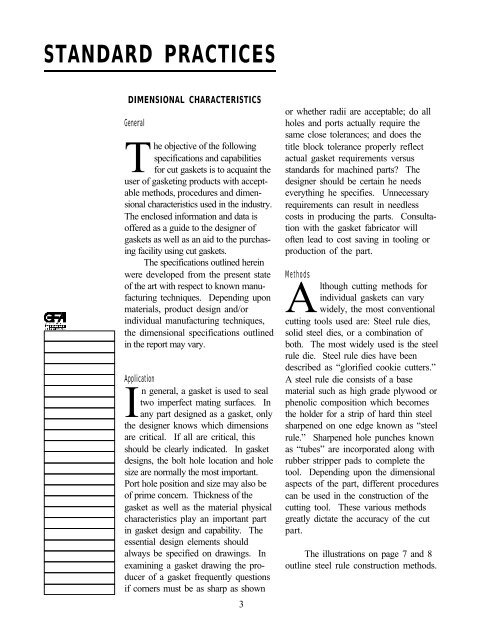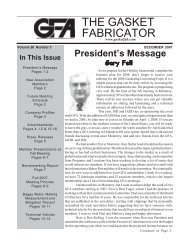Technical Handbook - Gasket Fabricators Association
Technical Handbook - Gasket Fabricators Association
Technical Handbook - Gasket Fabricators Association
You also want an ePaper? Increase the reach of your titles
YUMPU automatically turns print PDFs into web optimized ePapers that Google loves.
STANDARD PRACTICES<br />
DIMENSIONAL CHARACTERISTICS<br />
General<br />
The objective of the following<br />
specifications and capabilities<br />
for cut gaskets is to acquaint the<br />
user of gasketing products with acceptable<br />
methods, procedures and dimensional<br />
characteristics used in the industry.<br />
The enclosed information and data is<br />
offered as a guide to the designer of<br />
gaskets as well as an aid to the purchasing<br />
facility using cut gaskets.<br />
The specifications outlined herein<br />
were developed from the present state<br />
of the art with respect to known manufacturing<br />
techniques. Depending upon<br />
materials, product design and/or<br />
individual manufacturing techniques,<br />
the dimensional specifications outlined<br />
in the report may vary.<br />
Application<br />
In general, a gasket is used to seal<br />
two imperfect mating surfaces. In<br />
any part designed as a gasket, only<br />
the designer knows which dimensions<br />
are critical. If all are critical, this<br />
should be clearly indicated. In gasket<br />
designs, the bolt hole location and hole<br />
size are normally the most important.<br />
Port hole position and size may also be<br />
of prime concern. Thickness of the<br />
gasket as well as the material physical<br />
characteristics play an important part<br />
in gasket design and capability. The<br />
essential design elements should<br />
always be specified on drawings. In<br />
examining a gasket drawing the producer<br />
of a gasket frequently questions<br />
if corners must be as sharp as shown<br />
3<br />
or whether radii are acceptable; do all<br />
holes and ports actually require the<br />
same close tolerances; and does the<br />
title block tolerance properly reflect<br />
actual gasket requirements versus<br />
standards for machined parts? The<br />
designer should be certain he needs<br />
everything he specifies. Unnecessary<br />
requirements can result in needless<br />
costs in producing the parts. Consultation<br />
with the gasket fabricator will<br />
often lead to cost saving in tooling or<br />
production of the part.<br />
Methods<br />
Although cutting methods for<br />
individual gaskets can vary<br />
widely, the most conventional<br />
cutting tools used are: Steel rule dies,<br />
solid steel dies, or a combination of<br />
both. The most widely used is the steel<br />
rule die. Steel rule dies have been<br />
described as “glorified cookie cutters.”<br />
A steel rule die consists of a base<br />
material such as high grade plywood or<br />
phenolic composition which becomes<br />
the holder for a strip of hard thin steel<br />
sharpened on one edge known as “steel<br />
rule.” Sharpened hole punches known<br />
as “tubes” are incorporated along with<br />
rubber stripper pads to complete the<br />
tool. Depending upon the dimensional<br />
aspects of the part, different procedures<br />
can be used in the construction of the<br />
cutting tool. These various methods<br />
greatly dictate the accuracy of the cut<br />
part.<br />
The illustrations on page 7 and 8<br />
outline steel rule construction methods.







